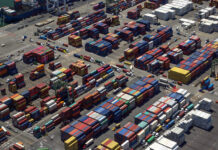
A team of French companies has allied with major Chinese naval architecture company SDARI, a subsidiary of the China State Shipbuilding Company (CSSC), and have designed a low-carbon feedership using wind energy to supplement main engine power.
The 2,500TEU Trade Wings design, developed by France’s yacht designer VPLP, consultancy Alwena, and Oceanwings, sail designer Ayro along with SDARI received its Approval in Principle from classification society Bureau Veritas.
Trade Wings 2,500 has a capacity of 2,500TEU and has an overall length of 197m and a breadth of 32m with a deadweight of 32,500 tonnes.
In a joint statement, the companies said the design, “Fosters the combination of a wind-assisted propulsion with six Oceanwings and LNG-electric propulsion with pods. The wingsails are installed on a vertical sliding mechanism to retract them partially while the vessel is in port, thus minimising the impact on cargo operations.”
In addition, the initial design will have an LNG storage tank based on the Mark III containment system designed by another French company, GTT. Trade Wings is designed with gas only four-stroke gensets only. A feature of this design is that the gensets can be upgraded at a later date to operate on zero carbon fuels including ammonia and hydrogen.

“Suitable for shortsea shipping operations or feedering in Europe, Central America, Caribbean Islands and China, the Trade Wings 2,500 can also operate on transatlantic trades. The design minimises time in port operations, as manoeuvrability is increased with the vessel’s pods, and the hatch coverless design further speeds up cargo operations,” said the vessel designers.
On a Transatlantic trip of around 4,000Nm, the designers estimate that the vessel will on average save 35% CO2-equivalent emissions compared to a conventional design, with a two-stroke engine, single shaft and without wingsails, at the same speed.
Of the 35% in carbon equivalent reductions, the designers say the Oceanwings sails will account for 57% of the reduction in emissions, while the optimised LNG propulsion will provide 43% savings.
Alex Gregg-Smith, senior vice president Bureau Veritas for North Asia said, “We have just released new wind propulsion system rules – and this innovative design, approved in principle by BV, including a sliding mechanism, demonstrates the feasibility of wind-assisted propulsion on board container ships with deck space limitations. Benefitting from a coverless hatch and LNG electric pod propulsion, the design provides both operational flexibility, improved efficiency and reduced carbon emissions, complying with, or exceeding, regulatory requirements.”








